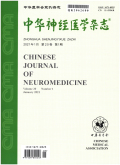G-CSF通过上调mTOR/p70S6K信号通路抑制新生大鼠HIBD后神经细胞凋亡
G-CSF ameliorates neuronal apoptosis via the mTOR/p70S6K pathway after hypoxia-ischemia brain damage in neonatal rats
摘要目的 探讨粒细胞集落刺激因子(G-CSF)对新生大鼠缺氧缺血性脑损伤(HIBD)后神经细胞凋亡的影响及哺乳动物雷帕霉素靶蛋白(mTOR)/p70S6K信号通路在其中发挥的作用. 方法 90只7d龄新生SD大鼠按随机数字表法分为假手术组、模型组、G-CSF组、雷帕霉素组及对照组,每组18只.后4组采用改良Rice-Vannucci法制备成HIBD模型,其中雷帕霉素组、对照组于HIBD前1h分别腹腔注射雷帕霉素250μg/kg或等体积乙醇;G-CSF组、雷帕霉素组及对照组于HIBD后1h腹腔注射G-CSF 50 μg/kg,假手术组、模型组予等体积生理盐水腹腔注射.HIBD后48h,采用2,3,5-三苯基氯化四氮唑(TTC)染色检测脑梗死面积并计算梗死面积比,Nissl染色评估海马CA1区及皮质神经细胞情况,TUNEL法检测海马CA1区及皮质神经细胞凋亡情况,Westernblotting检测脑组织中抗凋亡因子B淋巴细胞瘤-2基因(Bcl-2)及促凋亡因子Caspase-3活化片段(CC3)、Bcl-2相关X蛋白(Bax),mTOR、磷酸化(p)-mTOR及其下游p70S6K、p-p70S6K蛋白的表达. 结果 与模型组相比,G-CSF组和对照组梗死面积比明显减少,海马CA1区及皮质Nissl染色阳性细胞数明显增多、神经细胞凋亡指数明显降低,脑组织中CC3、Bax蛋白表达水平明显降低,Bcl-2蛋白表达水平明显升高,p-mTOR/mTOR、p-p70S6K/p70S6K比值明显升高,差异均有统计学意义(P<0.05).与G-CSF组和对照组相比,雷帕霉素组梗死面积比明显增加,海马CA1区及皮质Nissl染色阳性细胞数明显减少、神经细胞凋亡指数明显增加,脑组织中CC3、Bax蛋白表达水平明显升高,Bcl-2蛋白表达水平明显降低,p-mTOR/mTOR、p-p70S6K/p70S6K比值明显降低,差异均有统计学意义(P<0.05). 结论 G-CSF可能通过上调mTOR/p70S6K信号通路抑制HIBD后神经细胞凋亡.
更多相关知识
abstractsObjective To investigate the effects of granulocyte-colony stimulating factor (G-CSF) on neuronal apoptosis after hypoxia-ischemia brain damage (HIBD) and the possible role of the mTOR/p70S6K signaling pathway in neonatal rats.Methods Ninety seven-day-old Sprague-Dawley rats were assigned into 5 equal groups (n=18):sham group,HIBD group,G-CSF group,rapamycin group and ethanol group by random number table method.Pups were subjected to unilateral carotid artery ligation followed by 2hrs hypoxia or sham surgery.HIBD animals received normal saline,G-CSF (50 μg/kg),G-CSF combined with rapamycin (250 μg/kg) or ethanol (vehicle for rapamycin).Pups were euthanized 48hrs post-HIBD to quantify the percentage of brain infraction area.The pathomorphologic changes in the hippocampal CA 1 area and cortex were observed by Nissl staining.Neuronal cell death was determined using terminal deoxynucleotidyl transferase-mediated dUTP nick-end labeling (TUNEL).mTOR,activated mTOR (p-mTOR),p70S6K,activated p70S6K (p-p70S6K),Cleaved Caspase-3 (CC3),Bax,and Bcl-2 were quantified using Western blot analysis.Results G-CSF treatment resulted in significantly reduced percentage of brain infraction area (P<0.05) and neuronal apoptosis in the hippocampal CA1 area and cortex (P<0.05) after HIBD in neonatal rats.However,rapamycin administration reversed the neuroprotective effect of G-CSF.G-CSF administration ameliorated the pathomorphologic damage in the ipsilateral hemisphere.Compared with the HIBD group,the Nissl stained neurons significantly increased in the G-CSF group (P<0.05).Furthermore,G-CSF increased the expression ofp-mTOR,p-p70S6K and Bcl-2 but decreased the expression levels of CC3 and Bax in the ipsilateral hemisphere,which were all significantly reversed by rapamycin (P<0.05).Conclusion G-CSF may attenuate caspase activation and reduce neuronal apoptosis by up-regulating the activity of mTOR/p70S6K signaling pathway after experimental HIBD in rat pups.
More相关知识
- 浏览244
- 被引8
- 下载68


相似文献
- 中文期刊
- 外文期刊
- 学位论文
- 会议论文



 换一批
换一批 换一批
换一批



